Endo GS-4
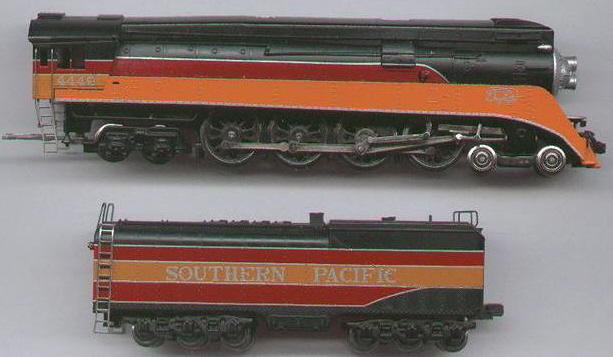
Samhongsa GS-3 (first run)

Samhongsa GS-4 (first run)
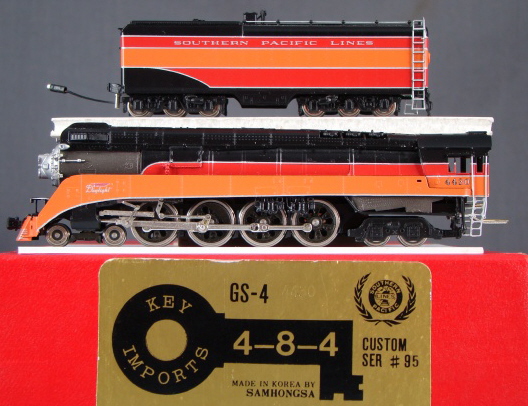
Samhongsa GS-5 (first run)

Samhongsa GS-4 (second run)
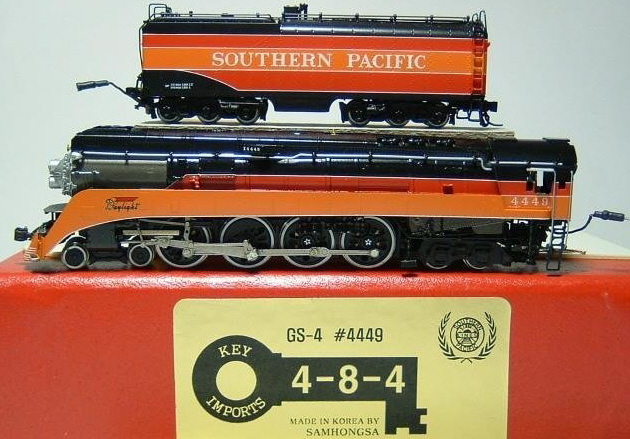
Samhongsa GS-5 (second run)
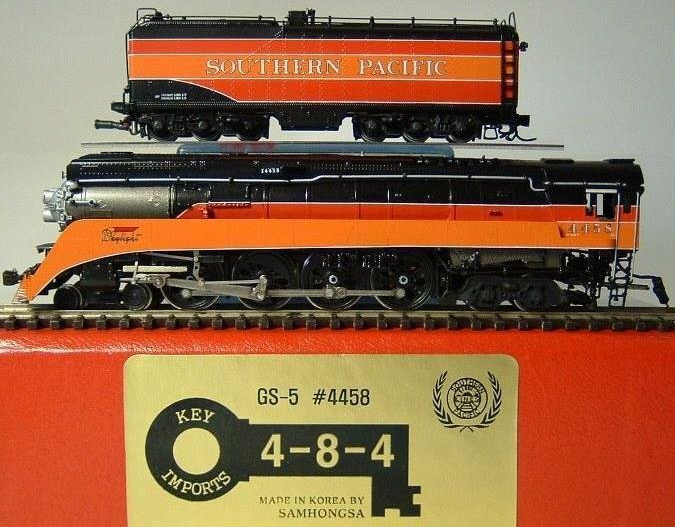
Endo GS-4

Samhongsa GS-3 (first run)

Samhongsa GS-4 (first run)

Samhongsa GS-5 (first run)

Samhongsa GS-4 (second run)

Samhongsa GS-5 (second run)

Introduced: 1984 (Endo/Japan GS-4), 1991 (Samhongsa/Korea GS-3, GS-4 and GS-5), and 2002 (Samhongsa again, same models)
The first Southern Pacific Daylight 4-8-4 imported by Key was manufactured by Endo (Japan). It was available in only one version - the above factory-painted GS-4 (#4449). The second run of Key SP 4-8-4's included GS-3s, GS-4s and GS-5s (1991, Ser #95). These were manufactured by Samhongsa (Korea). The third run (2002, Ser #127) was also manufactured by Samhongsa (same models). Not surprisingly, the Endo mechanism shares very little in common with the Samhongsa mechanism.
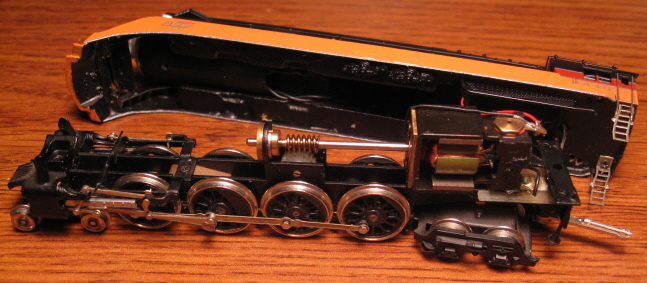
The Endo chassis is all-metal, although fairly minimalistic (with most of the weight coming from the shell). The motor is an open-sided 5-poler. Right-rail pickup is provided by the right four drivers. Left rail pickup is provided by the left six tender wheels (with current transferred to the motor by way of a stiff wire on the drawbar). All the rest of the wheels are electrically neutral. Wheel flanges are reasonably sized, so no problems with Code-55 track. The pilot coupler is a dummy knuckle. There isn't a coupler on the tender, although mounting a Micro-Trains coupler would appear to be a fairly simple operation. As delivered, there are no traction tires on any of the drivers. However, an ala carte TT-equipped driverset is included in the box should you want to make the switch.
The gearing is pretty simplistic - a brass worm gear transfers motion to a small white plastic gear, which in turn spins a large brass gear mounted on the axle of the third set of drivers (counting from the front). And that's it - all the rest of the drivers are turned by the running gear. Now, this is no doubt a fine system for prototypical locomotives, but as for a model? Not so much.
The Endo GS-4 has two non-directional (and non-Mars) headlights. And although the tender has a back-up light assembly built into it, it's a "dummy" (IE, there's a lense there, but no actual bulb inside the tender).
This model has some pretty serious limitations vis'a'vis its drawbar connection. So short is the drawbar (and consequently, so closely coupled are the locomotive and tender) that this model will instantly derail on curves with a radius sharper than 19" (and even 19"-radius curves can be a bit dodgy). Another problem is the way the drawbar mounts to the little metal post on the tender. The fit is so tight that the drawbar will actually lift the forward tender truck off the rails when faced with changes in grade (instead of simply sliding up the post).
As far as running on straight/flat track (or really broad curves) goes, this model is a decent performer. Throttle response is smooth, slow-speed creep is pretty good (if unspectacular), and the top-end speed isn't too crazy. Better still, it barely makes any noise at all, and the various moving parts dance around in a nicely syncopated symphony of non-wobbly and non-binding motion.
So, not the greatest locomotive in the world (especially a world that includes Kato's GS-4), but I guess if one were to modify the drawbar a bit (lengthen it and provide a larger hole for the tender pin), it could be a respectable runner.
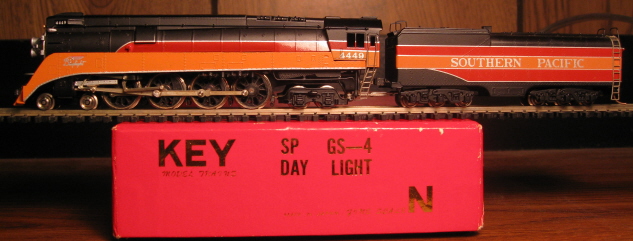
To remove the locomotive shell, unscrew the screw underneath the pilot truck and the two screws back by the trailing truck (note - not the ones holding the ladders). The shell should pull up and off at that point (if the back end sticks, just spread the cab sides apart a bit). Be careful, though - the wires running into the shell (for the headlight control unit) will prevent you from completely separating the shell from the chassis.
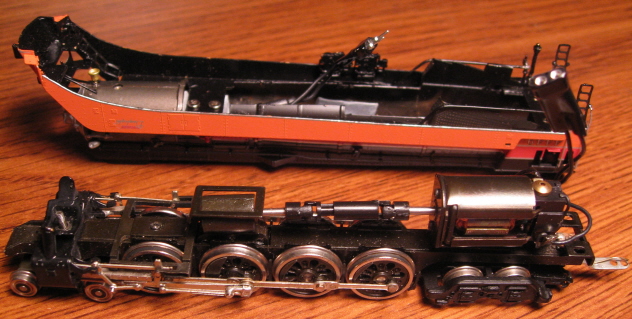
The Samhongsa chassis is all metal. And although fairly light and minimalistic, it does have a bit more structural support pieces than the Endo. The motor is an open-sided 5-poler. Right-rail pickup is provided by the four right-side drivers (the left drivers are electrically neutral - two of which are equipped with traction tires). Left-rail pickup is provided by all six left-side tender wheels (with current transferred to the motor via a stiff wire on the drawbar). All the rest of the wheels (both tender and locomotive) are electrically neutral.
The locomotive has two directional (non-Mars) headlights. Unfortunately, the light from the headlights is clearly visible from inside the smokestack (kind of lame, that). A working back-up light is mounted inside the tender (with right-rail current provided by a flexible insulated wire running from the locomotive into the tender). A pin/socket connection is provided, allowing one to separate the tender from the locomotive. The headlight wiring also has a pin/socket connection, so the locomotive shell and chassis can easily be separated. All gearing is plastic (as is much of the multi-piece driveshaft). Like the Endo, only one set of drivers is geared (with the rest of the drivers being turned by the cranks).
The pilot coupler is a dummy knuckle mounted to the shell. No coupler is provided for the tender, although screwing a Micro-Trains coupler into the provided hole in the tender is a simple operation. The wheel flanges are low-profile enough for Code-55 track. The pilot truck is spring-mounted, which should help it stay on the rails.
Overall performance on these Samhongsa models is quite good (and maybe even a little better than the Endos). They run smoothly and quietly. Pickup is good, and slow-speed creep is decent (if unspectacular). Unlike the Endos, the top-end speed is meteoric. The good news is that they don't seem to have the Endo's drawbar issues. The drawbar slides up and down on the tender mount readily, so no truck problems. Also, two holes are provided in the drawbar (one presumably for operation on narrower radius curves). Unfortunately, these models are still useless on curves with a radius narrower than 19". And this time it's the drivers and the pilot truck causing the problems (as opposed to the tender). When faced with sharp curves, the drivers and/or the pilot will hop the rails every time. So, a gorgeous model that runs very well - but don't bother trying to run one unless you have a huge layout with broad, sweeping curves.
First-run Samhongsas are labeled Ser #95. As for the second-run, I've read documentation that designates them as being Ser #127. However, since the label doesn't actually have a Ser # on it, there's no way to confirm that.
The second-run Samhongsas have a completely new / different motor (a coreless Faulhaber #1219). Additionally, the gearbox has been moved from the second set of drivers to the third. There are no traction tires, although a separate TT-equipped driver-set is included in the box. The headlights are upgraded to include actual Mars Lighting FX. As pictured above, they have considerably more external detail parts than did the first-run Sammys. And although I've never actually owned one of these second-run Sammys, I'm told that they run at least as well as the first run (if not better). Unfortunately, they are similarly limited to 19"-radius curves or broader.
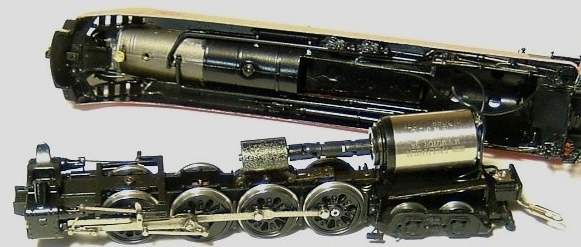
To remove the locomotive shell on these Samhongsas, unscrew the pilot truck screw and the two small screws under the cab. The shell should lift up and off at this point. To completely separate the shell from the chassis, first unplug the headlight wires.
Grade : C (for the Endo) and B (for the Samhongsa) - and "F" for both on sharp curves
(Thanks for 2nd run pictures, Ebi!)